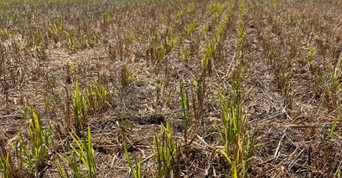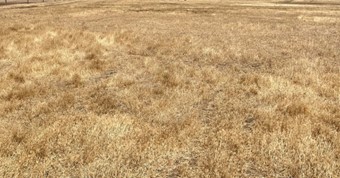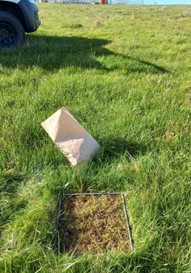Alternate summer forage crops for southern WA
Key points
Site one: Tenterden
- Millet oat mix had a higher nutritional value (NV) than the ryegrass clover control, with a higher crude protein, digestibility and metabolisable energy.
- Millet oat mix and ryegrass clover pasture had similar biomass of 2t/ha and 1.5t/ha respectively.
- Lambs on the millet had an average daily gain (ADG) of 3g/head, compared to no growth achieved by the lambs on the ryegrass clover mix.
Site two: Porongurup
- Winter wheat (DS Bennett) produced more than double the biomass at 88t/h across 85ha compared to the clover rye pasture that averaged 1.86t/ha across 25.5ha.
- Total livestock weight gain was 2kg/ha higher on the DS Bennett compared to the clover rye pasture.
- DS Bennett benefits extended beyond grazing, with 65ha being taken through to harvest (3.6 t/ha) and 17ha being cut for silage yielding 12t/ha.
Background
In 2020, Stirlings to Coast Farmers (SCF) began a three-year Producer Demonstration Site (PDS) with Meat & Livestock Australia (MLA) looking at alternative forage crops for southern WA. Growing alternate forage crops means producers can potentially grow cost effective feed which will be available to their livestock during the feed gaps during summer/autumn and winter periods. This offers producers an opportunity to increase profits, by carrying more livestock because they are confident of feeding animals outside the growing season, and by having livestock ready for market outside of peak supply times, producers will achieve higher prices. Producers typically calculate whole farm stocking rates based on their ability to carry stock over the autumn period. This project aimed to improve producers carrying capacity over this time and therefore increase stock carrying capacity and ultimately profits from increased livestock production.
Six producers hosted demonstrations sites over the three-year project from 2020 until 2023. The final two demonstrations were completed in 2022 in Tenderden (hosted by the Webster Family) and Porongorup (hosted by the Metcalfe Family).
During the 2022 spring, areas of the Great Southern region of WA recorded over 100mm of rain for November. This intensity of rainfall is not uncommon to this region and there is an opportunity for producers to take advantage of these events with alternate forage crops.
For the final year of the project the two demonstration sites were:
- Webster – Tenterden, lambs grazing millet (treatment) versus clover ryegrass mixed pasture (control).
- Metcalfe – Porongurup, yearling cattle grazing DS Bennett (treatment) vs Clover ryegrass mixed pasture (control).
Methodology/treatments
Site one: Tenterden
The Millet was seeded on 26 October 2022 at 8kg/ ha into a previously cut hay crop. Only millet was seeded, however, the 26ha paddock composition was approximately 80% millet and 20% volunteer oats. Within the first two weeks of seeding a cold front came through. Although there was a good germination, this caused the millet to have stunted growth and shows the importance of having the soil temperature at 14°C and rising. The millet was compared to a 20ha paddock of senesced clover ryegrass pasture.
Site two: Porongurup
The DS Bennett (winter wheat) was seeded into a 85ha paddock was seeded with DS Bennet winter wheat on 15 April 2022, sown at 115kg/ha. The crop received 150kg/ha of super potash 3:1 top dressed and 80L of Flexi-N per ha. A herd of 210 yearling heifers rotationally grazing 85ha of winter wheat (treatment paddock) and a herd of 35 yearling steers grazing a 25.5ha clover rye pasture (control paddock). Ideally, the cattle grazing the two treatments should have been of the same class, however, this was not possible at the time.
Measurements for both demonstrations
Measurements at both demonstrations for both the treatment and control paddocks included:
- biomass cuts for dry matter assessment
- soil samples
- plant samples for nutritive value (NV) analysis; and
- lamb/cattle weights (pre & post-grazing).
Results and discussion
Site one: Tenterden
The millet/oat mix had a much higher feed quality compared to the senesced clover/rye pasture (Table 1), with a 40% higher metabolisable energy and 22% higher crude protein. The millet/oat mix also had a higher digestibility of 68.7% compared to 52% in the clover ryegrass pasture.
Table 1: Nutritive value analysis of each forage, supplementation and biomass available before grazing
|
NV Analysis |
Ryegrass clover pasture |
Millet oat mix |
Supplementation (Home n’ Dry mix) |
Supplementation Oaten hay |
|
Dry Matter (DM) |
86.7 % |
28.6 % |
88% |
89.9 % of DM |
|
Moisture |
13.3 % |
71.4 % |
12% |
10.1 % of DM |
|
Crude Protein |
5.9 % of DM |
7.2 % of DM |
- |
5.0 % of DM |
|
Protein (N x 6.25) |
- |
- |
21.6 % of DM |
- |
|
Acid Detergent Fiber |
35.8 % of DM |
26.8 % of DM |
- |
30.5 % of DM |
|
Neutral Detergent Fiber |
70.0 % of DM |
54.9 % of DM |
- |
57.0 % of DM |
|
Digestibility (DMD) |
52.0 % of DM |
68.7 % of DM |
87.9 % of DM |
58.9 % of DM |
|
Digestibility (DOMD) |
50.8 % of DM |
65.0 % of DM |
- |
56.7 % of DM |
|
Est. Metabolisable Energy |
7.3 MJ/kg DM |
10.2 MJ/kg DM |
13.5 MJ/kg DM |
8.5 MJ/kg DM |
|
Fat |
2.7 % of DM |
4.6 % of DM |
- |
2.5 % of DM |
|
Ash |
7.2 % of DM |
7.4 % of DM |
2.1 % of DM |
2.1 % of DM |
|
Dry Matter cuts (DM) |
|
|
|
|
|
g of 0.1m² quad |
15.1 |
11.9 |
||
|
t/Ha |
1.5 |
1.2 |
||
Table 2: Merino lamb liveweight gains grazing on a senesced clover ryegrass pasture with supplementation compared to Shirohie millet oat mix at Tenterden January 2023
|
Description |
Ryegrass clover pasture |
Millet oat mix |
|
Grazing duration days |
12 |
12 |
|
Paddock size (ha) |
20 |
26 |
|
Stock numbers (head) |
100 |
1000 |
|
Stocking rate (lambs/ha) |
5 |
38.5 |
|
Weight in (kg lwt) or kg of liveweight |
30 |
30 |
|
Weight out (kg lwt) |
30 |
31 |
|
Weight gain (kg lwt) per lamb |
0 |
1 |
|
Average weight gain (grams/head/day) |
0 |
83.3 |
|
Total weight gain (kg lwt) |
0 |
1000 |
|
Total weight gain (kg lwt/ha) |
0 |
38.5 |
|
Supplementation |
|
|
|
oaten hay bale x3 * @$50/bale |
0 |
$150 |
|
400g/hd/day Home n’ Dry mix * @$350/t |
$168 |
|
|
150g/hd/day Home n’ Dry mix * @$350/t |
|
$630 |
|
Total cost of supplementation |
$168 |
$780 |
Even though the millet had slightly less dry matter, 1.2t/h compared to 1.5t t/ha for the clover ryegrass pasture, the higher feed quality led to increased weight gain of lambs on the millet, averaging 1kg/head over the 12 days. Keep in mind this was a very short crash grazing event due to the millet having stunted growth and showing signs of heat and moisture stress, however we wanted to use the feed before it was lost.
Both mobs received a bit of supplementation via lick feeders in their respective paddocks. The control lambs on the clover rye pasture also received an extra 250g/ head/day of Home n’ Dry mix while the millet lambs received an extra three bales of oaten hay over the 12 days (Table 2). Economic analysis showed both the traditional feed and the millet oat mix produced a loss of -$8.4 and -$43 respectively. Regarding the millet, the cooler temperatures after seeding definitely impacted on the feed availability and subsequent profitability of this forage crop.
Figure 1: Millet oat mix (left) and clover rye pasture (right)
 |
 |
Site two: Porongurup
The control paddock of clover and ryegrass pasture equated to 1.86t dry matter/ha across 25.5ha, and the DS Bennett wheat averaged 3.88t/h across 85ha (Figure 2). Both feed sources were relatively comparable in quality, with the DS Bennett being slightly higher quality (Table 3). Both had comparable crude protein at ~20%, with DS Bennett having ~5% less acid detergent fiber (ADF). ADF is the least digestible component of the plant, so the DS Bennett showed a slightly better digestibility than the clover and ryegrass pasture. The DS Bennett also had a higher metabolisable energy (ME) of 12.9MJ/kg DM compared to 10.6 MJ/kg DM in the clover ryegrass mix.
Figure 2: Biomass cuts of DS Bennet averaged 3.88t/ha (left) and clover rye pasture averaged 1.68t/ha (right)
 |
 |
Table 3: Nutritive value of each forage and biomass available before grazing
|
NV Analysis |
Clover rye pasture |
DS Bennett |
|
Dry Matter (DM) |
18.5 % |
14.9 % |
|
Moisture |
81.5 % |
85.1 % |
|
Crude Protein |
20.0 % of DM |
21.7 % of DM |
|
Acid Detergent Fiber |
22.1 % of DM |
17.3 % of DM |
|
Neutral Detergent Fiber |
42.5 % of DM |
37.9 % of DM |
|
Digestibility (DMD) |
71.1 % of DM |
84.3 % of DM |
|
Digestibility (DOMD) |
67.1 % of DM |
78.2 % of DM |
|
Est. Metabolisable Energy |
10.6 MJ/kg DM |
12.9 MJ/kg DM |
|
Fat |
5.6 % of DM |
6 % of DM |
|
Ash |
9.8 % of DM |
9.6 % of DM |
|
Dry Matter cuts (DM) |
|
|
|
g of 0.1m² quad |
18.63 |
38.83 |
|
t/Ha |
1.86 |
3.88 |
Table 4: Metcalfe yearling cattle liveweight gains grazing on a clover ryegrass pasture compared to DS Bennett winter wheat at Porongurup 2022
|
Description |
Clover rye pasture |
Winter wheat (DS Bennet) |
|
Grazing duration days |
40 |
40 |
|
Paddock size (ha) |
25.5 |
85 |
|
Stock numbers (head) |
35 |
210 |
|
Stocking rate (yearling cattle/ha) |
1.4 |
2.5 |
|
Weight in (kg lwt) or kg of liveweight |
389 |
385 |
|
Weight out (kg lwt) |
463 |
433 |
|
Weight gain (kg lwt) per head |
74 |
48 |
|
Average weight gain (kg/head/day) |
1.85 |
1.2 |
|
Total weight gain (kg lwt) |
2590 |
10080 |
|
Total weight gain (kg lwt/ha) |
101.6 |
118.6 |
This extra biomass and quality allowed the DS Bennett to support a higher stocking rate of 2.5 heifers/ha, compared to the 1.4 steers/ha on the clover rye mix (Table 4).
Winter wheat varieties are well-suited to the high rainfall zone and are a great alternate feed source. Advantages of DS Bennett include higher biomass production which in turn supports higher stocking rates of 2.5 heifers/ha, compared to the 1.4 steers/ha on the clover rye mix (Table 2). Sowing winter wheat early for early grazing opportunities can also allow producers to defer grazing.
This deferment allows these pastures to establish and increases subsequent pasture availability. Over the 40 days of grazing, the heifers on the winter wheat and the steers on the clover rye produced very similar net income at $493 and $498 per ha respectively. Even though the heifers produced an extra 17kg/ha (Table 2) this profit margin was consumed by the cost of sowing the winter wheat. However, there are other benefits DS Bennett can provide in regard to the versatile options available post grazing. These include either graze again, lock up for silage or take through to grain production. Tim took full advantage of these options and locked some up for silage and took the better parts through to grain contributing an extra $1,292/ha to their operation.



